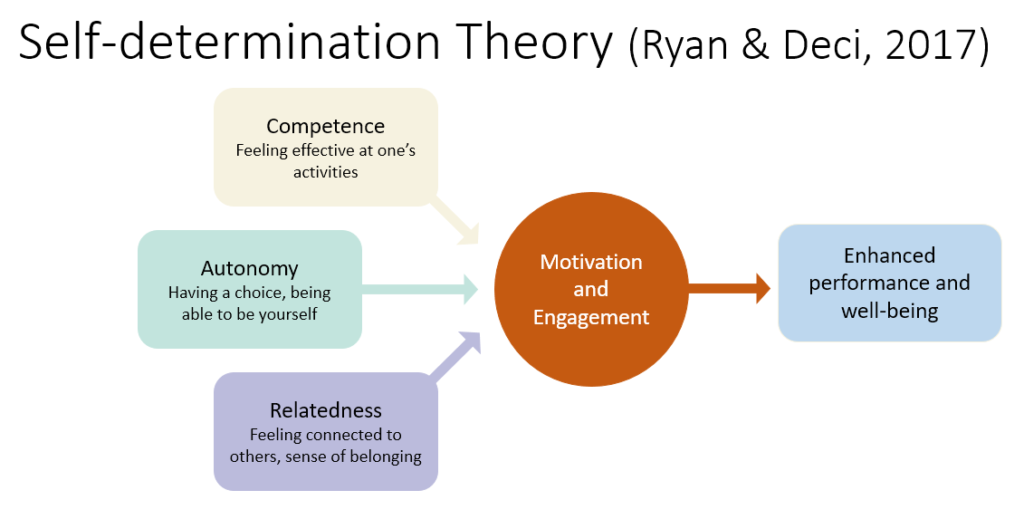Motivation and Self Determination Theory

Intrinsic and extrinsic motivation play a vital role in people’s lives. People get encouraged to do something when they are motivated. Deci and Ryan have highlighted both forms of motivation quite well, but more focus is placed on extrinsic motivation as they have elaborated its various kinds in detail and major portion of the article covers the details about extrinsic motivation.
Intrinsic motivation is a behavior that is molded by internal rewards. Intrinsic motivation is defined as the doing of an activity for its inherent satisfactions rather than for some separable consequence (Ryan and Deci, 2000). This motivation arises from within and has a satisfying effect. In other words, when someone finds pleasure and satisfaction in doing something without any external reward, it shows their intrinsic motivation. For example, if we read something for our aesthetic pleasure, we feel internally motivated to read that text without any external pressure or tension. Likewise, our hobbies like playing games, writing our personal diaries, painting, and cooking our favorite dishes can be good examples of intrinsic motivation. For hobbies, we do not think of any reward, we own them because they please us. On the other hand, extrinsic motivation is a reward-based behavior. Extrinsic motivation is a construct that pertains whenever an activity is done in order to attain some separable outcome (Ryan and Deci, 2000).
It is a form of Operant Conditioning in which reward and punishment are used to modify behaviors, approaches and to decrease or increase the tendency to do or not to do anything. For example, in extrinsic motivation, people are motivated through praise, money, fame and several other external factors. Doing a job to get a salary at the end of the month is a common example of extrinsic motivation. Sometimes, we offer candies and snacks to children, or promise to take them for a tour to their favorite places if they perform well in their studies. Any kind of praise, acknowledgement and different gestures of support can also be examples of external motivation. It is not a compulsion that the reward or acknowledgement will always be in a tangible form. For example, some kind words, appreciation, praise, and fame.
Ryan and Deci (2000) have described four different forms of external motivation. They are external regulation, introjection, identification, and integration. External Regulation is a behavior that is controlled by external factors. For example, telling our kids that they will be rewarded if they get good grades. They will study intentionally as they want to, but their studying will be affected by the rewards that they will expect from us. Introjection is an internal pressure that is the result of ego, tensions, guilt, peer support, and other kinds. People perform due to different obligations not due to internal pleasure. Identification is a good side of external motivation. People take actions keeping goodwill. For example, if a person consciously joins an organization to polish their skill, it is their self-selected goal. They get motivated to work for that organization. They take that decision intentionally, but they still have an external motivation factor. Integration is the best type of motivation. This type of motivation helps people self-reflect, understand the reasons, see if the reason matches their needs, and after analyzing a situation completely, they act. Although it is their conscious decision but the person following integrated regulation experiences several options and external factors that influence them.
According to my personal experience, both extrinsic and intrinsic motivation have their distinct roles in joining different communities. It depends on our needs and preferences which community we are going to join. The decision we take is based on the type of motivation that guided us to take that decision. I can give my own example. I join different cooking communities because cooking gives me pleasure and these communities develop my interest and motivation level to learn more about different recipes, organization methods, different kitchen hacks and much more. The involvement of external motivation can be vividly seen in educational communities like Canvas and Moodle. We join these communities to stay updated about our weekly assignments, different scholarship programs, upcoming tasks, peer interactions, grades, and much more. Likewise, we join communities like Linked In to improve our links for various job opportunities, to expand our businesses, to develop contacts, to advertise our products and much more. These external factors keep us motivated to join various communities.

SDT is an approach to human motivation and personality that uses traditional empirical methods while employing an organismic metatheory that highlights the importance of humans’ evolved inner resources for personality development and behavioral self-regulation (Ryan, Kuhl, & Deci, 1997). According to self-determination theory, people are motivated to change by three psychological needs. They are competence, autonomy, and relatedness. Competence is about the proficiency of people to perform a task. The mastery to perform a task shows their competence. People can control the outcomes and this control helps them gain mastery over the task. Autonomy makes people independent. For example, when students rely on their abilities and help themselves, they experience autonomy. Autonomy also leads them to regulate themselves. Through autonomy, they get more creative, productive, and self-dependent. Finally, relatedness brings people feel accepted and a sense of belonging develops in them. It is especially important in classrooms and various learning communities to develop relatedness in the learners so that they may feel relaxed and wanted in a specific environment. Relatedness can be developed through social connections, care, concern, and respect for each other.
References
Ryan, R. M., & Deci, E. L. (2000). Intrinsic and extrinsic motivations: Classic definitions and new directions. Contemporary Educational Psychology, 54-67. doi:10.1006/ceps.1999.1020
Ryan, R. M., Kuhl, J., & Deci, E. L. (1997). Nature and autonomy: An organizational view of social and neurobiological aspects of self-regulation in behavior and development. Development and psychopathology, 9(4), 701-728.